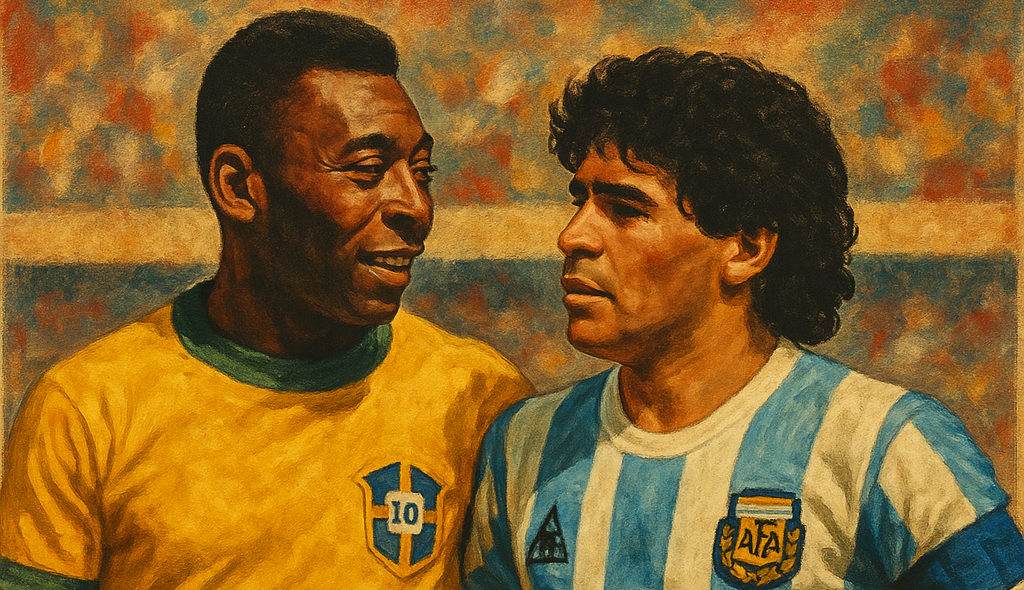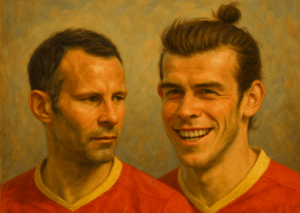
The 20th Century’s GOAT: Who Reigns Supreme in Football History?
When asked who the greatest footballer of all time is, the conversation almost invariably narrows down to two names: Pelé and Diego Maradona. Their rivalry transcends a mere battle of statistics; it represents the clash of two conflicting ideals that the sport of football strives for. While Pelé ascended to the throne as ‘The King’ (O Rei) through flawless skill and an overwhelming career, Maradona was revered as a ‘God’ (D10S) for his divine talent mixed with human flaws.
For a long time, this debate has relied on emotion and fragmented memories. Now, in 2025, we can illuminate this grand debate with a more objective and multi-faceted perspective, thanks to vast amounts of data and modern analytical frameworks. This article aims not just to answer the simple question of ‘who was better,’ but to delve into the very essence of the legacies these two giants left on football history.
1. The Truth in Numbers: A Comparative Analysis of Career Statistics
Every great debate must start with objective facts. The verified official records of both players provide a solid foundation for comparing their greatness.
Club and National Team Records
| Category | Pelé | Diego Maradona |
|---|---|---|
| Total Official Club Goals | 680+ Goals | 300+ Goals |
| Key Club Goals | 643 (Santos) | 115 (Napoli) |
| National Team Goals | 77 Goals | 34 Goals |
| National Team Caps | 92 Appearances | 91 Appearances |
| Goals per Game (National) | 0.84 | 0.37 |
Performance on the World Cup Stage
| Category | Pelé | Diego Maradona |
|---|---|---|
| World Cup Appearances | 4 | 4 |
| World Cup Matches Played | 14 | 21 |
| World Cup Goals | 12 | 8 |
| Goals per Game (World Cup) | 0.86 | 0.38 |
| World Cup Titles | 3 (1958, 1962, 1970) | 1 (1986) |
Major Career Honors
| Pelé’s Major Honors | Diego Maradona’s Major Honors |
|---|---|
| FIFA World Cup Winner (3 times) | FIFA World Cup Winner (1 time) |
| Campeonato Brasileiro Série A (6 times) | Italian Serie A (2 times) |
| Copa Libertadores (2 times) | UEFA Cup (1 time) |
| Intercontinental Cup (2 times) | Coppa Italia (1 time) |
| IOC Athlete of the Century (1999) | FIFA World Cup Golden Ball (1986) |
| FIFA Player of the Century (Joint Winner, 2000) | FIFA Player of the Century (Joint Winner, 2000) |
2. Artists on the Pitch: Playing Style and Tactical Roles
Pelé: The Textbook Complete Forward
Pelé possessed all the abilities required of a modern forward.
- Perfect Two-Footed Player: He could unleash powerful and accurate shots with both his right and left foot.
- Physicality and Aerial Prowess: His incredible jumping ability and balance allowed him to perform ‘magic in the air’.
- Playmaking Ability: He holds the all-time record for World Cup assists with 10, showcasing his ability to create for others.
- Tactical Role: Playing as an inside forward or second striker in Brazil’s 4-2-4 formation, he laid the groundwork for the modern ‘Number 10’ role.
Maradona: The Unpredictable Genius, the ‘Enganche’
Maradona was a player who could not be confined to a conventional framework; he was a tactical system in himself.
- Dribbling and Ball Control: His dribbling, utilizing a low center of gravity and explosive acceleration, was a nightmare for defenders.
- Creativity and Vision: His greatest weapons were his vision to read the game and his creativity to execute plays no one else could imagine.
- Tactical Role – ‘Enganche’: Given absolute freedom within Argentina’s 3-5-2 formation, he roamed the entire pitch, controlling the tempo of the attack and dominating the game.
3. History-Making Moments: Re-examining Iconic Scenes
The Myth of Pelé: The 1958 and 1970 World Cups
- 1958 World Cup Final vs. Sweden: A 17-year-old Pelé controlled the ball with his chest inside the penalty area, flicked it over a defender’s head (a ‘sombrero’), and volleyed it into the net without delay. This goal, one of the most beautiful in World Cup history, announced the arrival of a new ‘King’.
- 1970 World Cup Final vs. Italy: In the final moments, Pelé delivered a perfectly weighted, no-look pass to the onrushing captain Carlos Alberto. This pass was the final flourish on what is considered the greatest team goal in World Cup history, perfectly demonstrating his football intelligence that elevated team harmony above individual skill.
The Saga of Maradona: The 1986 Mexico World Cup
- ‘The Hand of God’: In the quarter-final against England, Maradona scored by using his hand. This goal transcended a mere refereeing error; for the Argentine people, it became a ‘symbolic revenge’ for their defeat in the Falklands War, cementing his mythic status. It symbolized his rebellious and cunning genius that defied the rules.
- ‘The Goal of the Century’: Just four minutes later, Maradona picked up the ball in his own half and dribbled approximately 68 meters, beating five English players before scoring. This goal was a testament to his unstoppable, god-like individual ability.
4. Beyond the Team: The Level of Teammates and Leagues
Pelé’s Brazil vs. Maradona’s Argentina
The Brazilian national teams of 1958, 1962, and 1970, for which Pelé played, were among the strongest in history, filled with legendary players like Garrincha, Rivelino, and Jairzinho. In contrast, the 1986 Argentine team that Maradona led to victory was not considered a side brimming with world-class stars, besides him.
- Maradona was directly involved in 10 of Argentina’s 14 goals (5 goals, 5 assists) in the 1986 World Cup, demonstrating the maximum possible impact a single player can have on a team.
League Competitiveness: 1960s Brazilian League vs. 1980s Serie A
In Pelé’s era, the Brazilian league was considered world-class, and his club, Santos, proved themselves the best in the world by defeating European champions. In contrast, the Italian Serie A in the 1980s was known as the ‘battleground of football,’ arguably the most defensively robust league in history. In this environment, Maradona worked a miracle, leading the underdog team Napoli to two league titles.
5. Icons Beyond Football: Cultural Impact and Legacy
Pelé: A Symbol of Peace, The Globalization of Football
Pelé was the first global superstar who introduced the sport of football to the entire world.
- The Man Who Stopped a War: The famous story of a 48-hour ceasefire during the Nigerian Civil War in 1969, just so people could watch him play.
- Brazil’s National Treasure: The Brazilian government designated him a ‘national treasure’ to prevent his transfer to a European club.
- Football Diplomat: He was instrumental in boosting football’s popularity in North America and spread positive messages through the sport as a UNESCO Goodwill Ambassador.
Maradona: A Rebel Icon, The God of Naples
Maradona was a symbol of rebellion against the establishment and represented the hopes of the marginalized.
- The Savior of Naples: He delivered the first-ever league title to the southern Italian city of Naples, becoming revered as the city’s patron saint.
- Anti-Imperialist Symbol: The ‘Hand of God’ goal was perceived as symbolic revenge for the defeat in the Falklands War.
- A Critic of the System: Throughout his life, he criticized powerful institutions like FIFA, speaking out for the voiceless.
6. The View from Giants: Testimonials from Contemporaries
- Johan Cruyff: “Pelé was the only footballer who surpassed the boundaries of logic.”
- Franz Beckenbauer: “Pelé is the greatest player of all time. He reigns supreme. There’s no one to compare with him.”
- Pelé on Maradona: “Maradona was a great player, but he couldn’t head the ball well and didn’t use his right foot.”
- Maradona on Pelé: “If the people had voted, I would have been the best player of all time, without a doubt.”
Conclusion: The King and The God, Two Summits – The Final Verdict of 2025
After all this analysis, declaring a single, clear winner is both impossible and, frankly, meaningless. The reason is that these two players are two colossal peaks, each symbolizing a different form of greatness.
‘The King’, Pelé
He was the embodiment of perfection, the ideal benchmark for what the sport of football could be. He achieved an unprecedented three World Cup titles and, with an immaculate image on and off the pitch, introduced football to the world as ‘The Beautiful Game.’ He was the ‘King’ who perfected the order of the football kingdom and reigned from its apex.
‘D10S’, Maradona
He was art itself, sculpted by unpredictable genius. He performed miracles, leading an ordinary team to the pinnacle of the world with his divine dribbling and creativity. His life was a drama of glory and disgrace, and fans loved him even for his human flaws, elevating him to the status of a ‘God’.
Ultimately, the choice between Pelé and Maradona comes down to which kind of greatness we value more. Do we revere the king who dominated an era with consistency and perfection? Or do we celebrate the revolutionary who created divine moments amidst his own imperfection? There is no single right answer to this debate. Perhaps the very fact that this argument will never end is the most definitive proof of the greatness of both men. Their light was like lightning that shook the world. The history of football will forever follow the brilliant paths these two giants left behind.




